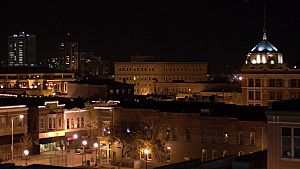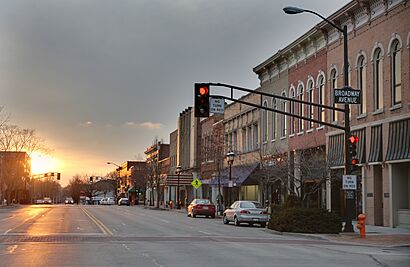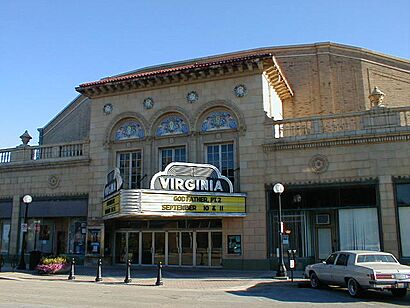Champaign–Urbana metropolitan area facts for kids
Quick facts for kids
Champaign–Urbana Metropolitan Area
|
|
|---|---|
|
Combined Statistical Area
|
|

Downtown Champaign, Illinois
|
|
| Nicknames:
C-U, Chambana
|
|
| Country | |
| State | |
| Largest city | Champaign |
| Other cities | Urbana Rantoul Danville |
| Population
(2022)
|
|
| • MSA | 236,514 |
| • CSA | 308,851 |
| Time zone | UTC−6 (CST) |
| • Summer (DST) | UTC−5 (CDT) |
The Champaign–Urbana area (sometimes called Chambana) is a busy region in central Illinois. It's home to about 236,514 people (as of 2022), making it one of the larger city areas in the U.S. The main cities here are Champaign and Urbana. This area is also where the University of Illinois Urbana-Champaign is located. This university is a very important part of the University of Illinois.
As of 2023, the Champaign–Urbana area includes Champaign County, Piatt County, and Ford County. This area is part of an even larger region called the Champaign–Urbana–Danville Combined Statistical Area. This bigger area also includes the Danville area and has a population of 308,851 people (as of 2022).
Many people see Champaign–Urbana as one big city. For example, in 1998, Newsweek magazine listed it as one of the top ten tech cities outside of Silicon Valley. Also, in 2007, Country Home magazine named Champaign–Urbana as one of the top twenty-five green cities in the United States.
Contents
- Growing Cities: Champaign and Urbana
- Living Outside the Main Cities
- Population Data
- Fun Things to Do: Tourism and Recreation
- Learning Centers: Colleges and Universities
- Arts and Culture Scene
- Media Outlets
- Getting Around: Transportation
- Sports and Athletics
- Famous People from Champaign–Urbana
- See also
Growing Cities: Champaign and Urbana
The downtown area of Champaign has changed a lot since the year 2000. The city government has worked hard to bring in new buildings and businesses. They have invested money and offered help to developers.
For example, the 9-story M2 on Neil building was built. It kept the front of an old bank building. This building has homes, shops, and offices. This mix of uses is common in new city developments. A 9-story Hyatt Place hotel also opened nearby in 2014.
Near the University of Illinois, new tall apartment buildings have been built. The 24-story 309 Green building opened in 2007. It is taller than the older 21-story Tower at Third. The Burnham 310 Project, which is 18 stories tall, finished in 2008. It has luxury apartments for students and a County Market grocery store. This building connects downtown Champaign to Campustown.
Many other mixed-use buildings (apartments above shops) have been built in Campustown. Some are as tall as 26 stories.
University Campus Upgrades
The University of Illinois campus has also seen big changes. Memorial Stadium, where the football team plays, has been updated. It now has new stands and luxury suites. The State Farm Center, which opened in 1963, is home to the basketball team. It was renovated starting in 2014 and now hosts concerts and other events again.
In downtown Urbana, the bell tower of the Champaign County Courthouse was restored. This project made the courthouse look even better. All these new buildings and updates make Champaign and Urbana feel more like big cities.
Living Outside the Main Cities
The areas around Champaign and Urbana are different from many other city suburbs. Instead of just endless suburbs, you find large areas of farmland. There are also many small to medium-sized villages that started as farming towns.
However, more people are now willing to drive further to work. Because of this, new homes are being built on the edges of these villages. Some of these villages have thousands of residents, but most are smaller.
Commuting to Champaign and Urbana
Many people in these nearby communities work in Champaign or Urbana. These areas include places like Savoy, Mahomet, St. Joseph, Tolono, Rantoul, and Monticello. Most of these are in Champaign County.
People who work at the University of Illinois Urbana–Champaign, hospitals, or in the Research Park often live in these areas. They might have higher incomes and prefer single-family homes. These areas often have higher average incomes than Champaign or Urbana. This is partly because they rely on cars for commuting and have fewer apartments.
New neighborhoods are also growing in areas just outside the city limits. The cities themselves are also growing and adding these new areas. People in annexed areas get city services like sewers and police. But some developments choose to stay outside the city. They pay lower taxes because they get fewer services.
Land Development and Growth
New construction is happening west of I-57 and near Willard Airport. Some of this land is in Champaign Township. Other parts have been added to Champaign or Savoy. More land development is happening north of I-74 in areas added by both Champaign and Urbana.
On the east side of Urbana, new businesses are being built. These include stores like Meijer and Menards, plus many restaurants. More suburban homes are also being built there.
Local governments often debate about new land development. They discuss if new buildings are good for the area. They also argue about annexations. When an area is annexed, it means property tax money goes from the surrounding townships to the cities. This helps the cities' tax base but also means they need to provide more services.
Population Data
The table below shows the population of the Champaign-Urbana area and its surrounding counties over the years.
| CBSA | 2023 Population (est.) | County | 2023 Population (est.) | 2020 Population | 2010 Population | 2000 Population | 1950 Population | 1900 Population |
|---|---|---|---|---|---|---|---|---|
| Champaign-Urbana, IL MSA | 235,608 | Champaign County, Illinois | 205,644 | 205,865 | 201,081 | 179,669 | 106,100 | 47,622 |
| Piatt County, Illinois | 16,714 | 16,673 | 16,729 | 16,365 | 13,970 | 17,706 | ||
| Ford County, Illinois | 13,250 | 13,534 | 14,081 | 14,241 | 15,901 | 18,359 | ||
| Danville, IL μSA | 71,652 | Vermilion County, Illinois | 71,652 | 74,188 | 81,625 | 83,919 | 87,079 | 65,635 |
| Champaign-Urbana-Danville CSA | 307,260 | |||||||
Fun Things to Do: Tourism and Recreation
Museums to Explore
- Champaign County Historical Museum: This museum is in an old bank building from 1858. It shows exhibits about the history of the area and the Midwest.
- Museum of the Grand Prairie: Here you can learn about what life was like in the early Midwest.
- Krannert Art Museum: This art museum has both modern and classic art. It often has new exhibits to see.
- Orpheum Children's Science Museum: A fun, hands-on science museum just for kids!
- Spurlock Museum: This museum has over 46,000 items about human culture and history from all over the world. It has some of the biggest exhibits on Native North American and South American history in the country.
- Monticello Railway Museum: A railroad museum with exhibits about central Illinois. You can even ride a tourist train here!
Parks and Outdoor Fun
- Champaign Park District: This district has many parks, hiking trails, and biking trails in the city of Champaign.
- Urbana Park District: This district includes trails for exercise and biking, Crystal Lake, a sculpture park, and other public places in Urbana.
- Robert Allerton Park: This used to be a private estate. It has a large manor house (now a conference center), beautiful gardens, and natural woodlands. It is open to everyone.
Learning Centers: Colleges and Universities
- The University of Illinois Urbana–Champaign is a major university located in both Urbana and Champaign. It is the main campus for the University of Illinois system.
- Parkland College is a community college found in Champaign.
Arts and Culture Scene
The Champaign-Urbana area has many theaters. The University has three main venues: Foellinger Auditorium, the State Farm Center, and the Krannert Center for the Performing Arts.
The State Farm Center is mostly for basketball games and concerts. The Krannert Center for the Performing Arts is known as one of the best places for performances in the country. It hosts over 400 shows every year. Built in 1969, it has four theaters and an amphitheater.
Historic Theaters
The Historic Virginia Theatre in downtown Champaign is a public place. It is famous for hosting Roger Ebert's Film Festival every April. The Virginia Theatre also has community theater shows, popular movies, live music, and other performances. It first opened in 1921 for both movies and live shows. The Champaign Park District took control of it in 2000. Its original Wurlitzer pipe organ is still played regularly.
The Art Theater in downtown Champaign was the city's first movie theater, opening in 1913. It showed unique films. It closed in 2019. The Orpheum Theatre, built in 1914, closed in the 1980s. It is now a children's science museum.
Parkland College in Champaign has a small theater and a planetarium called the William M. Staerkel Planetarium.
Music and Food Scene
Many famous musicians have come from this area. These include REO Speedwagon, Head East, Dan Fogelberg, and Alison Krauss. Other bands like HUM and American Football also started here. Champaign-Urbana is known for its variety of rock music.
The cities host the Pygmalion Music Festival every year. Many well-known artists have performed there, such as Iron and Wine and Andrew Bird.
Champaign-Urbana has many different restaurants. You can find everything from breakfast spots to fancy dinner places. There are also many choices for vegetarians and vegans. The area has even won awards for its food, like the 'Greatest Food Town' award from Midwest Living magazine in 2017.
Media Outlets
Besides regular newspapers, radio, and TV stations, Champaign-Urbana has several unique media groups.
- WEFT 90.1 FM is a community radio station. It started in 1981 and plays music from around the world. It also has news and public affairs shows. All the hosts are volunteers.
- WRFU-LP is a low power community radio station. It was built by volunteers in 2005. WRFU plays music, news, and talks about local issues on 104.5 FM.
- Illini Media is located near the university. It runs the college radio station WPGU 107.1. Illini Media also publishes the Daily Illini, a student newspaper, and Buzz Weekly, which covers arts and entertainment.
- Smile Politely is an online magazine that started in 2007. It focuses on arts, entertainment, and local news.
Getting Around: Transportation
In 2009, the Champaign-Urbana area was ranked fourth in the U.S. for the number of people who walked to work (9 percent). In 2013, it was ranked eleventh lowest for people who drove alone to work (78.4 percent). This means many people here use other ways to get around.
Roads and Highways
Interstate 74 goes east–west through Champaign and Urbana. Interstate 57 runs north–south through the west side of Champaign. Interstate 72 ends in Champaign. U.S. Routes 45 and 150 also pass through the cities. Illinois Routes 10 and 130 start in Champaign and Urbana.
Public Transit
The Champaign-Urbana Mass Transit District provides bus service in the area. Its main station is Illinois Terminal. This station also connects to bus services for Rantoul and Danville.
Illinois Terminal is a regional transportation hub. You can catch Greyhound Lines and Burlington Trailways buses there. It also has Amtrak train service with the City of New Orleans, Illini, and Saluki routes.
Air Travel
The University of Illinois Willard Airport is in Savoy, south of Champaign. It offers air service through American Eagle.
Sports and Athletics
The Champaign-Urbana area does not have any professional sports teams. However, the University of Illinois has many sports teams. They compete in the Big Ten Conference.
Memorial Stadium and the State Farm Center (formerly the Assembly Hall) are both in south-east Champaign. Memorial Stadium is where the Fighting Illini football team plays. The State Farm Center is home to the successful Fighting Illini basketball team. The NFL's Chicago Bears even played in Memorial Stadium for the 2002 season while their home stadium was being fixed.
The city of Champaign has explored having a professional baseball team. This team would be part of the Frontier League.
The University of Illinois hosted the 2013 NCAA Division I Men's and Women's Tennis Championships. These were held at the Kahn Outdoor Tennis Complex in Urbana. The Illini Men's Tennis team won the national championship in 2003.
Since 2009, Champaign-Urbana has been the home of the Illinois Marathon.
Famous People from Champaign–Urbana
Many notable people have come from the Champaign–Urbana area or went to the University of Illinois Urbana–Champaign:
- American Football, rock group
- Philip Anderson, Nobel Prize winner in Physics
- Marc Andreessen, software engineer; co-writer of the Internet browser Mosaic
- John Bardeen, two-time Nobel Prize winner in Physics
- Bonnie Blair, Olympic speedskater
- Emily Blue, pop singer
- Braid, rock group
- Dick Butkus, hall of fame NFL football player, played for U of I
- Iris Chang, book author, historian
- Roger Ebert, film critic
- Dave Eggers, writer
- Jennie Garth, actress, director
- Red Grange, Illinois football RB, Chicago Bears RB, NFL Hall of Famer, #1 Big Ten Icon
- George Halas, founder/former owner of the Chicago Bears
- Erika Harold, Miss America 2003
- Nick Holonyak Jr., inventor of the visible light-emitting diode
- Hum, rock group
- Mannie Jackson, owner of the Harlem Globetrotters
- Robert L. Johnson, founder of BET
- Shahid Khan, CEO/owner of Flex-N-Gate and owner of the Jacksonville Jaguars
- Alison Krauss, bluegrass singer
- Jonathan Kuck, Olympic speed skater
- Don Laz, Olympic pole vault medalist
- Ang Lee, filmmaker
- Jimmy John Liautaud, owner of the sandwich chain Jimmy John's
- Ludacris, rapper
- Jack McDuff, jazz organist and organ trio bandleader
- Tatyana McFadden, five-time US Paralympian winning 17 medals and 18 IPC World Championship medals
- Tracey Meares, law professor
- Nichole Millage, Paralympic volleyball player
- Nick Offerman, actor, writer, humorist, carpenter
- Nina Paley, cartoonist, illustrator, and blogger
- Ron Popeil, infomercial inventor
- C.W. Post, breakfast cereal magnate
- Richard Powers, writer
- Katherine Reutter, Olympic speed skater
- Blake Schilb, an American professional basketball player
- Daniel B. Shapiro, former US Ambassador to Israel
- Hamilton O. Smith, won Nobel Prize in Physiology or Medicine in 1978
- REO Speedwagon, rock group
- Starcastle, progressive rock group
- Sasha Velour, an American drag queen and winner of Rupaul's Drag Race in 2017
- David Ogden Stiers attended high school in Urbana (with Roger Ebert)
- Thelma Strabel, novelist
- James Tobin, won Nobel Memorial Prize in Economics in 1981.
- David Foster Wallace, writer
- George Will, political columnist
- Stephen Wolfram, founder and CEO of Wolfram Research & Wolfram Alpha
- Timothy Zahn, Hugo-award-winning author attended U of I and began his writing career there
- Tony Khan, All Elite Wrestling chairman and head booker
See also
 In Spanish: Área metropolitana de Champaign-Urbana para niños
In Spanish: Área metropolitana de Champaign-Urbana para niños



